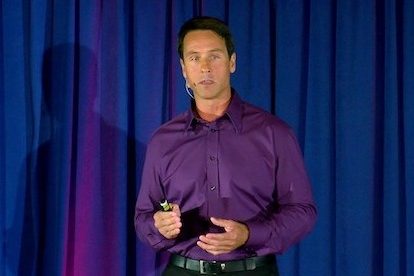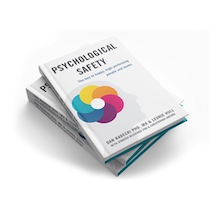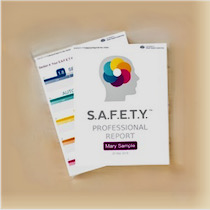On Thursday, Donald Trump gave his acceptance speech at the Republican National Convention. These speeches are a candidate’s opportunity to rally the party around their candidacy. The speech is a means to ignite passion and mobilize the energy of delegates to go out and enrol others to vote for the candidate. How the candidate delivers this speech sets the tone for the sales pitch of the whole party. It is the message that goes out to the public about what the candidate stands for and why to vote for them. A lot can be gleaned from this speech and we decided to apply a neuroscience model to the speech and see if we can understand what approach and emotional triggers the candidate is using to motivate, persuade, and inspire voters.
Before I tell you what we learned from our calculation, let me explain the concept and methodology used. First, the brain responds to threats and rewards. We call this “towards” and “away” emotions. The brain has about 5 times more circuitry dedicated to “away” stimuli than dedicated to “towards” stimuli. This is why the rule of thumb in management is “five strokes for one poke”. It takes 5 positive stimuli to overcome one negative one. Every time a candidate says something that evokes a threat, we count that towards a fearful tone of the speech, and every time a candidate says something that invokes hope or some reward, then we count that as an optimistic tone of the speech. So, we can understand how much fear or optimism is present in the speech.
We have looked at each item in the speech and counted it as a “towards emotion”, “away emotion” or a “towards AND away emotion”. Some sections were very short (11 words) other sections were very long (191 words). We counted a total of 112 different and distinct sections to the speech and we looked both at raw quantity of sections as well as the number of words in each section to get a percentage of “toward” and “away” emotions used by the candidate in his speech.
For each section, we also checked which “emotional trigger” was pushed. In some cases, there were more than one trigger. These triggers can be mapped to the S.A.F.E.T.Y.™ Model developed by the Academy of Brain-based Leadership. S.A.F.E.T.Y.™ is underpinned by years of research by neuroscientists, social psychologists, and others and stands for: Security, Autonomy, Fairness, Esteem, Trust and You. We have omitted the YOU part for now as that one is individual while science shows us that the rest apply to all humans.
Security
Is the brain’s need for predictability and can be simplified into the C’s in the brain’s environment. The brain likes consistency, clarity, certainty and dislikes change.
Autonomy
Is the feeling of control over one’s environment (whether the control is real or not.) A sensation of having choices within any given situation is rewarding to the brain. Let’s face it, few of us like to be told what to do!
Fairness
We want exchanges that occur within our environment to be fair – to us and to others. Fair exchanges are intrinsically rewarding, independent of other factors. When something is seen as unfair, the brain deals with it using the same networks as those involved with disgust.
Esteem
This domain covers the topics of how we view ourselves, how we compare ourselves with others, and our opinions of how we think others view us.
Trust
This domain addresses our social needs. We thrive in tribes; initially, however, we treat each new person, or person outlined as different from us, as a stranger or threat. They are part of our ‘out-group.’ As we establish commonalities, they become part of our ‘in-group’, and we now use a different brain network to deal with them.
So, for example, a statement like “First, my plan will begin with safety at home which means safe neighborhoods, secure borders, and protection from terrorism” would have been a positive statement because we want to go “towards” that paradigm, and the trigger would have been “Security”. In contrast, the statement “Not only have our citizens endured domestic disaster, but they have lived through one international humiliation after another” would be a negative statement because it activates our threat circuitry. And the trigger would have been “Esteem” because it talks about our humiliation. Another example statement is “we are going to deal with the issue of regulation, one of the greatest job killers of them all”, which would again be a negative statement because it makes us want to go “away” from something, in this case regulation. And the triggers would have been “Fairness” and “Esteem” because the bad regulation is unfair and costs us our esteem (jobs).
Fearful or optimistic?
After going through the whole speech using this methodology, we can say that Donald Trump’s sales pitch is mostly based on threat and fear. The speech included 57% of the sections and 66% of the word count being oriented towards statements that were likely to evoke the brains threat circuitry. Since we have many more brain circuits dedicated to identifying threats, most people should have walked away feeling fearful about the current status of the country. Not surprising, the majority of the optimistic statements had to do with himself and his ability to fix those issues.
The Speech should have made you feel like “going away” from the current situation/leadership and “going towards” Trump, which is what I am sure he hoped to accomplish. The opposition has painted him as a man without experience, with a questionable business past, and an uneven temperament. To make such a man the President of the United States would tend to evoke a threat response in the domain of Security. The easiest way to overcome that threat response was to create a bigger perceived threat in regards to maintaining the status quo. So, by portraying the current state of affairs to be so negative across almost all S.A.F.E.T.Y.™ domains, he was able to overshadow any non-conscious security fear associated with himself.
Which emotional triggers were targeted?
When it comes to the S.A.F.E.T.Y.™ Profile of the speech, we can say the biggest trigger he pressed with the audience, by a large margin, was Trust. This was a surprising find because we think of Trump as someone focusing on Security.
Although he talked about Security, it was overshadowed by Trust and Esteem, and tied with Fairness. He barely talked about Autonomy. (I guess the Libertarians already have the autonomy dimension wrapped up in their platform.)
It seemed he really wanted to paint Hillary, Obama, and current leadership as a group connected with the unFairness of illegal immigration, foreign countries who take advantage of America, special interests who pillage the poor, terrorism and lawlessness which he accuses them of being complacent about. His message is not so much about security as it is about painting Hillary and the establishment as unTrustworthy to take care of America. Most news outlets focused on Trumps dystopian view of America, but they missed his main non-conscious trigger: Trust. Based on the media’s focus of his speech, it seemed like his “Trust” attack was secondary to his negative view of America. However, the negative paradigm was a necessity for the Trust attack to work its non-conscious magic.
And what did he offer to our non-conscious need for something positive? The answer – Esteem. As we typically check our Esteem many times per second, it is a powerful offering. With a campaign message of “Make America Great Again” it should not surprise us that he hit on Esteem, and of course he is the one who can give it to us. So, we can expect Trump to continue to hammer on the Untrustworthiness of Clinton and the currency he will continue to offer in exchange for your vote is Esteem.
Were you influenced?
Of course, for this speech to have its desired impact, the audience needs to be receptive to his provocations on those dimensions. He has to play to the sensitivities of his audience and the more sensitive his audience is to the triggers he used, the more likely they are to follow his lead and get on board with his campaign. Someone looking for an optimistic message would have been turned off by this speech but likely would have still been influenced by the fear in the message. If you don’t Trust Trump, then his arguments probably fell flat because you did not let anything he said touch you. And if you believe that America is already great, then the Esteem argument probably did not have an impact on you either. However, esteem is a special trigger in that our brain’s never have enough esteem. So, like any get rich quick scheme, no matter how rich you are, you will always wonder if you could be richer and worry you may be missing out on something by not participating. Therefore, even if someone does not trust Trump, if they have a high sensitivity to Esteem, they may end up casting that vote in the hopes Trump will deliver and improve their Esteem. As I hope you can see, the positions taken in his speech seemed obvious, but how they impacted the audience nonconsciously may have more impact on the final vote than we may realize.
If you would like to get an idea of your sensitivities to the S.A.F.E.T.Y.™ triggers, you can take the S.A.F.E.T.Y.™ Assessment for free and see your top Domain. Find out your top bias to understand how politicians may work to influence your vote.
It will be interesting to see how Hillary’s speech compares next week, so look out for my follow up next week.










